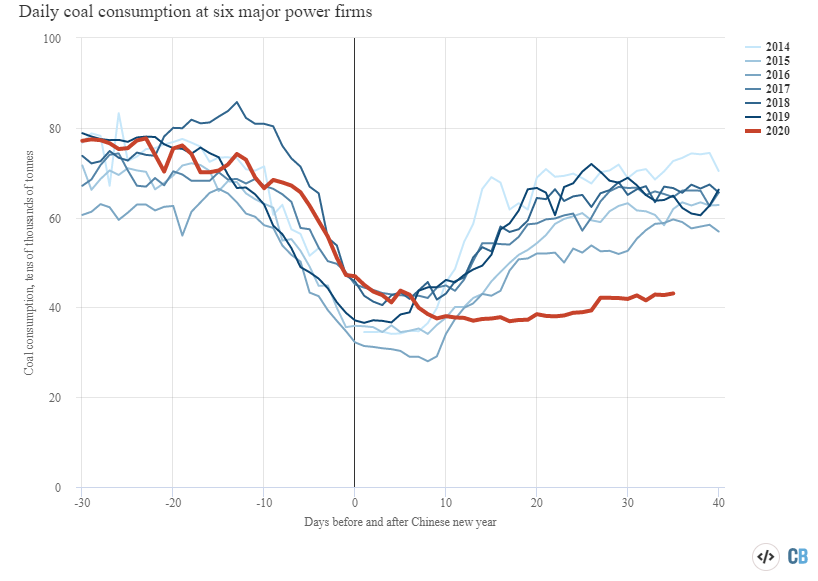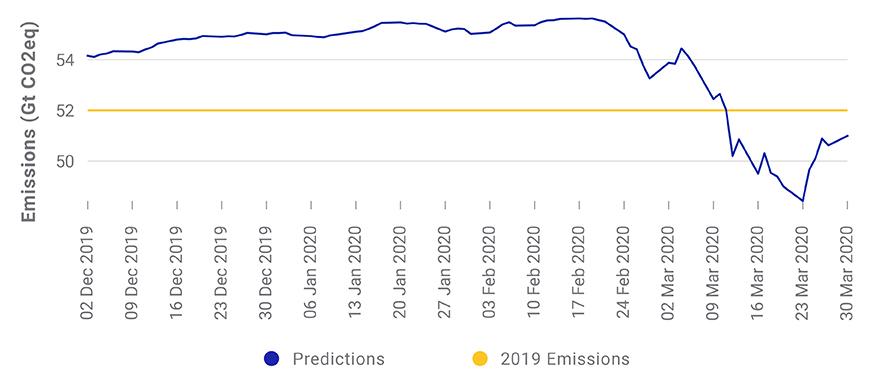What impacts will the COVID-19 pandemic have on the longer-term climate change disaster? I’ll begin to address this topic here, starting with some observations, and expand upon it with some suggestions in future blogs. Throughout my more than 8 years of running this blog, I have emphasized the global energy transition, I have aimed to apply a variety of strategies to maximize economic performance while minimizing the impact of energy use on the climate. Understanding COVID-19’s impacts on the energy transition will benefit all of us in our quest to optimize future prospects.
The pandemic started in Wuhan, China, reaching its first peak around the end of January. The first cases were reported toward the end of December 2019, and the virus was identified on January 7th. By January 23rd, the city of Wuhan went into complete lockdown; the rest of China followed shortly.
Figure 1 illustrates the country’s almost immediate drop in coal use around the Chinese New Year (January 25th). It shows the coal consumption at six power plants, compared to previous years. Initially, there appeared to be no significant difference because the Chinese New Year is a holiday that usually leads to sharp drops in economic activity and therefore in power consumption. However, after the holiday, for every year but 2020, the economic activity and power consumption soon returned to normal. We can directly associate 2020’s drop of about 25% in coal consumption with attempts to block COVID-19 via an extended lockdown. That lockdown marked a halt to most economic activity, which in turn resulted in a major decrease in coal consumption across China.

Figure 1 – Drop in China’s coal consumption at six major power firms, surrounding the Chinese New Year (January 25th)
As the virus spread around the world, lockdowns followed—and with them, a sharp decrease in energy use. More than 80% of the world’s energy still originates in fossil fuels. Figure 2 shows estimated global carbon emissions as they reflect the growth of the pandemic.

Figure 2 – Model estimating global carbon emissions for 2019 – early 2020
One cannot measure changes in global carbon emissions on a daily basis in the same way that we look at changes in coal use (Figure 1) but intuitively, everyone has predicted major pandemic-driven reductions in carbon emissions. After all, economic activity—measured in terms of GDP/Capita (see February 24, 2015 blog)—is the dominant term in driving carbon emissions. It is not a surprise then, that a drastic virus-powered economic decline will result in a major drop in carbon emissions.
By the same token, since the pandemic is self-terminating, either through herd immunity or effective vaccine, it doesn’t take a rocket scientist to predict that once the pandemic runs its course, energy use and resulting carbon emissions will return to pre-pandemic levels. In the meantime, though, we can enjoy a clear view of the Himalayas from New Delhi and a much cleaner sky almost everywhere on Earth.
However, one of the coronavirus’ direct impacts on energy use will probably be longer lived. This has to do with our use of electricity. Most of us, locked in and forced to do our work remotely, cannot escape the need for more electricity. Almost everything that we do at home now requires it. As I’ve mentioned in previous blogs (see October 22, 2019), electricity is a secondary energy form. In most cases, that requires conversion from a primary energy source, many of which originate with fossil fuels and emit a lot of carbon dioxide. The conversion efficiency from primary energy to electricity is a little more than 30%. We can see this difference directly by comparing the price of a unit of energy derived from electricity to one derived directly from oil, natural gas or coal (think for example, heating a room). We pay about three times more for the energy coming from electricity than that from direct fuel.
Doing everything from home, especially during the summer, when the air-conditioners, TV, and all of our computers are constantly on, increases the amount of electricity that we use significantly. However, we mustn’t forget the piece that we have just cut out of the picture: our workplaces. Those extra buildings require even more electricity.
Figure 3 shows the total power load in New York City on April 16, 2020 compared to the same date in 2019.

Figure 3 – Electricity use in New York City on April 16, 2020 and the same date on 2019
We see a clear decline in electricity use. Every indication suggests that some of this result from an increase in the amount of work that we can perform remotely from home. That’s a factor that may well become permanent once the pandemic runs its course. This transition will probably leave other major imprints on our energy use. I will address some of the more extreme consequences of some of these developments next week.

As devastating as the virus has been for many, it shows how impactful of a change we have on our planet. I believe that we should adapt in changes that reduce our carbon impact and energy like those of now, so we can save this planet and avoid climate crisis in the future.